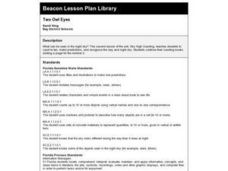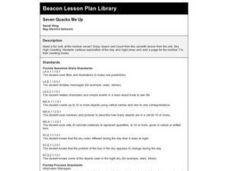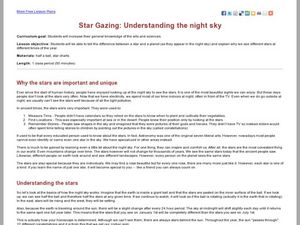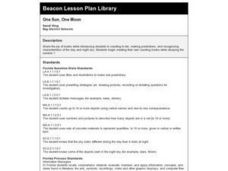Curated OER
Objects in the Sky
Young scholars explore what the sky looks like at different times. They identify objects in the sky and recognize changes over time. Students observe the sky and look for objects that are common in both the daytime and the nighttime sky.
National Center for Case Study Teaching in Science
Mask of the Black God
Finally, an astronomy lesson for the high schooler! Explorers are able to read star maps for finding objects in the night sky by determining celestial coordinates. In particular, they locate the Pleiades and read about a Navajo legend...
Curated OER
What Can You See in the Sky?
In this objects in the sky activity, students will compare what they can see in the sky during the day and during the night. Students will complete 8 fill in the blank statements.
Curated OER
SKY PATHS: STUDYING THE MOVEMENT OF CELESTIAL OBJECTS
Students observe the position of an object in the sky by describing its location relative to another object or the background, describe an object's motion by tracing and measuring its position over time, and create their own myths about...
Curated OER
Day And Night
For this short excerpt worksheet, students read and discuss what they can see at night, what they can see during the day and then answer three comprehension questions.
Curated OER
Day and Night
Students using experiments try to demonstrate how observations can be affected by the cycles of night and day.
Curated OER
The Starry Night Time and Day Time
Second graders complete a unit of lessons on the solar system. They complete various art projects inspired by Van Gogh's 'Starry Night,' create a moon phases book, create a moon phase wind chime, develop a timeline of space exploration,...
Curated OER
Shadow Trackers
Students use online websites to inquire about the cycle of day and night. In this web based lesson, students are able to see the movement of the sun and Earth. Students can look at different parts of the Earth as if they were on the Sun...
Colorado State University
What Is a "Model"?
Model the transfer of energy during a typical 24-hour period. Young scholars use a game-like approach to learning the patterns of heat transfer through the day and night. Groups of four exchange different tokens as the energy...
Curated OER
Water Works Wonders
Students examine where water is found in the world, how we use it, and the various forms it takes. They observe the refraction of light through a prism, record the day and night sky over a week's time, and create a topographic model of...
Curated OER
Sky 2: Shadows
Students explore space science by participating in a shadow experiment. In this sky observation lesson, students identify how the sun creates different sized shadows by moving across the horizon. Students utilize yard sticks, markers,...
Curated OER
Sky Watchers: Ancient Astronomers
Students close their eyes and picture the sky. They are asked to brainstorm things they may see in the course of a night and day, such as the movement of the sun, moon, and stars. Students work in groups to coduct their research. They...
Curated OER
Azimuth and Altitude
Learners use a compass and their hands to find positions of stars and planets in the night sky or of the sun during the day.
Curated OER
Two Owl Eyes
First graders listen to the story, Olivia Counts, and demonstrate counting to ten. They make predictions, and recognize the day and night sky. They add page number 2 to their counting books.
Curated OER
What is April Fool's Day?
Students explore humor by creating their own practical joke. In this April Fool's Day lesson, students read different situations in which practical jokes were taken too far. Students discuss their reactions to the jokes and identify when...
Curated OER
Sky High Counting
Students learn the characteristics of the day and night sky, and the movement of the sun across the sky as they learn to count to ten in this unit.
Curated OER
Seven Quacks Me Up
First graders explore the day and night sky and add a page for the number 7 to their countiing books.
Curated OER
Guided Reading "In the Night Sky"
Learners participate in a variety of reading exercises, such as choral reading and reading response journal, to reinforce concepts about space and nocturnal animals.
Curated OER
Star Gazing: Understanding the night sky
Young scholars observe star charts to understand the difference between a star and a planet. In this star lesson plan, students also explain why we see different stars at different times of the year.
Curated OER
The Starry Night
Second graders fingerpaint their own interpretations of Vincent Van Gogh's Starry Night.
Houghton Mifflin Harcourt
Nature Walk: English Language Development Lessons (Theme 2)
Walking in nature is the theme of a unit designed to support English language development lessons. Scholars look, write, speak, and move to explore topics such as camping, woodland animals, instruments,...
Curated OER
Science: Day and Night
Students listen to the Sky Tellers Native American story, "Ant Dances for Light," and illustrate it. They observe how Earth's rotation results in periods of darkness and light. Students investigate how day length varies throughout the...
Curated OER
World In Motion Curriculum
Young scholars explore the night sky and its solar system. Using a Digitarium planetarium system, students observe four constellations. They discover the phases of the moon and eclipses. Young scholars recognize the difference between...
Curated OER
One Sun, One Moon
First graders read "Ten Black Dots" by Donald Crews and then create their own counting books focusing on the number 1 (one) and using yellow dots to represent the sun, moon and stars.

























